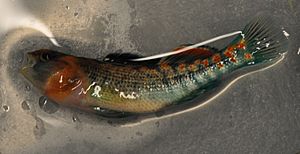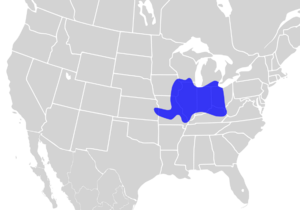Orangethroat darter facts for kids
Quick facts for kids Orangethroat darter |
|
|---|---|
 |
|
| A male orangethroat darter | |
| Conservation status | |
| Scientific classification | |
 |
|
| Synonyms | |
|
The orangethroat darter (Etheostoma spectabile) is a small, colorful freshwater fish. It belongs to the darter group, which is part of the Percidae family. This family also includes well-known fish like perch.
This darter lives only in the central and eastern United States. You can find it in parts of the Mississippi River and Lake Erie areas. It likes to live in cool, shallow streams with gravel bottoms. It also enjoys rocky areas in small rivers and creeks. The orangethroat darter searches for food on the bottom. It eats tiny water insects like midge and mayfly larvae. This fish lays its eggs in the spring. It often chooses shallow, gravelly spots in streams. Scientists say this species is not in danger. Its conservation status is "least concern".
Contents
Where the Orangethroat Darter Lives
The orangethroat darter is found in North America. It lives in parts of the Mississippi River Basin and Lake Erie Basin. Its home stretches from southeastern Michigan and Ohio all the way to eastern Wyoming.
The fish's range goes south into Tennessee and west into northern Texas. In Texas, it mostly lives on the Edwards Plateau. You can often find this darter in good quality habitats across middle Tennessee. It also lives in parts of the Cumberland River and Tennessee River systems. Some groups of these fish are found near Reelfoot Lake.
What Orangethroat Darters Eat and Where They Live
Orangethroat darters mainly eat small water insects. Their diet includes larvae of midges, blackflies, and caddisflies. They also eat mayfly nymphs and tiny crustaceans called isopods and amphipods. What they eat can change with the seasons and as they get older.
These darters prefer streams with slow to fast-moving water. They like shallow areas with gravel bottoms. You might also find them in rocky parts of small rivers and creeks. They enjoy places with sand, gravel, or bedrock at the bottom. Sometimes, they live in quiet backwaters or spring runs. This fish is most common in water that has high alkalinity. They seem to avoid rivers with very strong currents.
Young darters often drift downstream into calmer pools. They might even move into smallmouth bass nests. This helps them find food and stay safe from predators. Larger fish like trout or smallmouth bass might eat orangethroat darters.
Reproduction and Life Cycle
Male orangethroat darters are usually smaller than females. However, males often prefer smaller females for mating. There are many more males than females in this species, about seven males for every one female.
The breeding season for the orangethroat darter usually starts in mid to late March. They like to lay their eggs at the top ends of shallow, fast-moving parts of streams called riffles. These spots have sandy and gravelly bottoms with some larger rocks.
Female darters can carry anywhere from 20 to 250 eggs. The eggs are quite tough. They can hatch well in a wide range of temperatures, from 10°C to 27°C (50°F to 81°F). Many eggs successfully hatch, and many young fish survive their first year. This is partly because young darters often seek out large bass nests for food and protection.
Orangethroat darters become old enough to reproduce when they are about one year old. At this age, they are only about 30 millimeters (1.2 inches) long. Young darters grow to about 45 millimeters (1.8 inches) in their first year. By their second year, they can reach 60-70 millimeters (2.4-2.8 inches). The biggest orangethroat darter ever recorded was about 74 millimeters (2.9 inches) long. However, they are usually much smaller than that.
Protecting the Orangethroat Darter
The orangethroat darter is considered a "least concern" species. This means it is not currently at risk of disappearing. There are many of them, and not many things limit their numbers.
However, the biggest threat to these fish is pollution. This pollution comes from urbanization, which is when cities and towns grow bigger. Run-off from roads and developed areas can carry harmful substances into streams.
A study in Indiana showed that building a new highway could harm fish. It could lower the number of fish species, including the orangethroat darter. This happens because the highway could make the nearby creek water less clean.
So, it's important to watch and control pollution that flows into rivers and streams. This helps protect all the fish that live there. Current plans focus on reducing things like too many nutrients, pesticides, and dirt in the water. These plans help the entire fish community in a watershed.
While there are general plans to protect rivers and fish, there are no specific plans just for the orangethroat darter. Protecting their habitats helps them thrive.



